Study on the consumption and uses of edible fungi by selected ethnic tribes/groups in selected geographical regions in Nepal is lacking. This paper highlights the various ways of using Termitomyces spp. in Tarai, Siwalik and Midhill in Nepal. The investigation was conducted before, during and after monsoon, from 2010 to 2012. Data were obtained by interacting with members of the ethnic groups used in this study, as well as interviews. It was found that there were nineteen termitomyces taxa, used as food and medicine.
Wild edible mushrooms are one of the most important non-timber forest products in the world. Due to their vigorous growth in the rainy season, delicious taste and nutritional value, termite mushrooms are mostly used for consumption. Over the last decade, mushrooms have been studied as a novel functional food mainly in South East Asian countries (Adhikari, 2000) and in the world (Khan et al., 2013). Mushrooms have high quality of protein, minerals and vitamins but low fat content (Chaube, 1995). Thus, mushrooms have been used as food since time immemorial.
In Nepal, wild edible mushrooms are one of the most important minor forest products, which are locally traded in local market throughout the country (Adhikari, 2000). Due to the high content of protein (36.8%) in Termitomyces mammiformis (Adejumo and Awosanya, 2005), 10 to 14% vitamins (ascorbic acid) in Termitomyces clypeatus (Ogundana and Fagade, 1981; Tibuhwa, 2012) and 2.17% minerals (Potassium) in T. albuminosus. Termitophilous mushrooms are very important for their edibility and nutraceutical utility (Aryal, 2015). Previous studies have asserted that the maximum protein content and best amino acid balance are found in mushrooms just before the caps expand (Spores A Field, 2011).
Termitophilous fungi (termite’s mushroom) are a monophyletic group of tropical gilled mushrooms belonging to the genus Termitomyces. They are unique fungi that grow in close and intimate association with termites. It was described by Heim (1942a,b,c) for a group of termitophilous agarics. Its history begins in Nepal by the reports of T. eurrhizus (Singh and Shrestha, 1986). It comprises fungi that live in an obligate symbiosis with termites (commonly known as white ants) of the subfamily Macrotermitinae and order Isoptera. Termitomyces spp. was recorded from tropical and subtropical regions of the world (mainly from Africa, and South and South East Asia). However, samples were also recorded in Portugal of Europe and Ecuador of South America (Aryal, 2015).
Fruiting bodies of Termitomyces spp. are a delicacy in different parts of the world, most importantly in Equatorial region of Africa (Nigeria, Zambia, Zimbabwe, Tanzania, Uganda and Cameroon), South Africa, Madagascar and South-east Asia (India, China, Nepal, Pakistan, Sri Lanka, Thailand, Taiwan, Philippines, Burma, Indonesia and Malaysia) (Heim, 1942c, 1977; Turnbull and Watling, 1999). Several researchers have estimated the nutritional values of fruiting bodies of Termitomyces species (Bother and Eicker, 1992).
Termitomyces species are reported to contain higher dry matter, digestible lysine-rich protein, fiber, vitamins and minerals, but contain lower amount of fat and carbohydrates (Jiskani, 2001). They are also rich in important minerals, like phosphorus, potassium, calcium, copper and iron (Aryal, 2015). In place of starch, mushrooms contain sorbitol and linoleic acid (an unsaturated fatty acid). They are an excellent source of folic acid, thiamine, riboflavin, niacin, pantothenic acid and biotin (Manning, 1995). Besides nutritional value, many species of Termitomyces possess antioxidant properties and thus have high medicinal value (Tibuhwa, 2012). They also produce a variety of enzymes in culture media useful as additives in food, in leavening of bread, in processing silage and in other industrial applications (e.g., clarification of non-citrus fruit juices) (Khowala et al., 1992).
Based on the above, the study being reported aimed at determining the various ways of using Termitomyces by the different ethnic groups and community inhabiting different eco-zones of Nepal. The main aim of the present study is to document different mushroom types with details of uses emphasizing Termitomyces spp.
The survey of termitomycetes was carried out in Tarai, Siwalik and Midhill during Southwest and post-monsoon seasons (June-November, 2010-2012). Termitomyces spp. were recorded in different habitats like mixed plantations, Acacia, Dalbergia, Tectona monoculture forests, Agro pastoral, Community managed Forest, Government managed National Forest, Plantation Forest, Government managed in Protected Area, Sacred groves and natural (evergreen, moist deciduous and Sal) forests (Figure 1). These were conducted on the basis of information obtained from the local informants of varied ethnic groups in different seasons of the years when the study was done. The interviews were also taken based on indigenous knowledge. The specific locations range from Jhapa-Ilam to Kanchanpur-Dadeldhura (latitude of 26°44ʹ08ʺ N and 29°06ʹ32ʺ N and between the longitude of 80°18ʹ02ʺ E and 88°08ʹ27ʺ E; Tables 1 and 2).
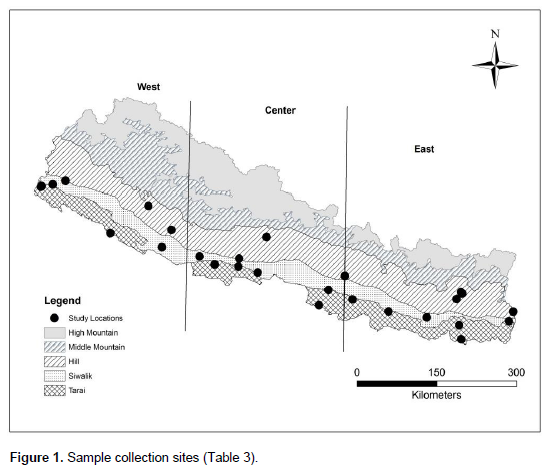
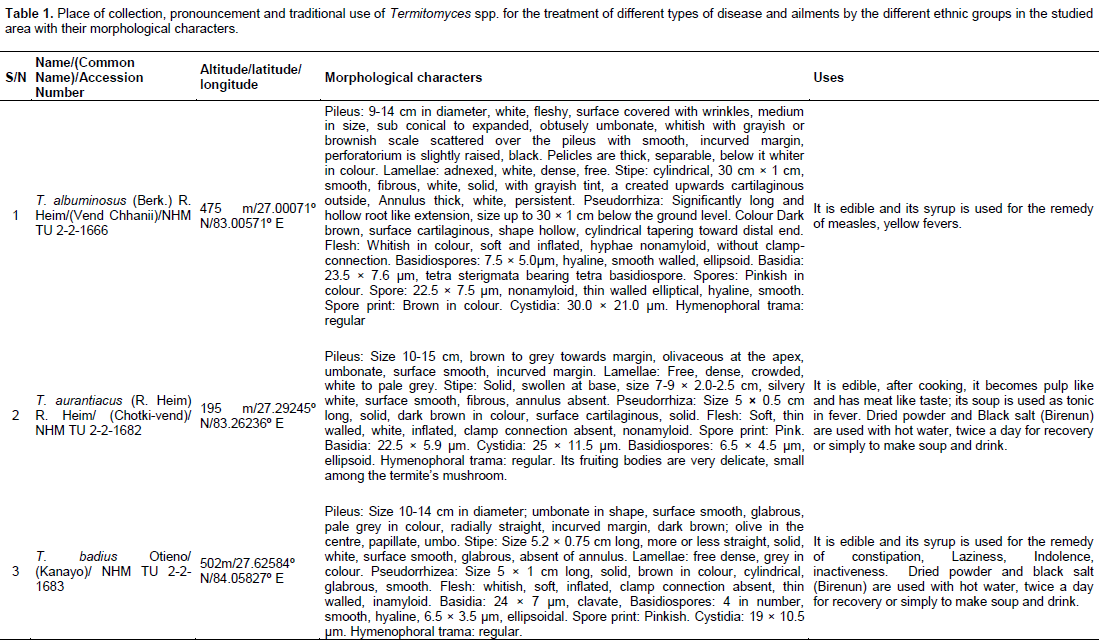


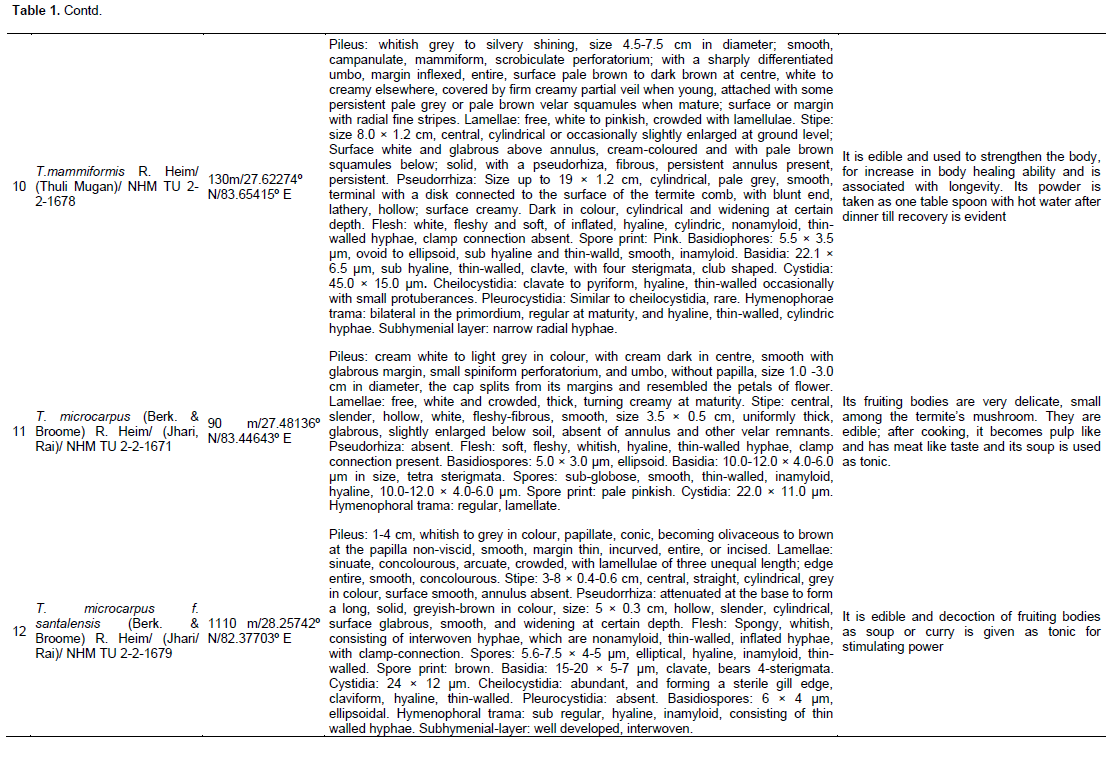

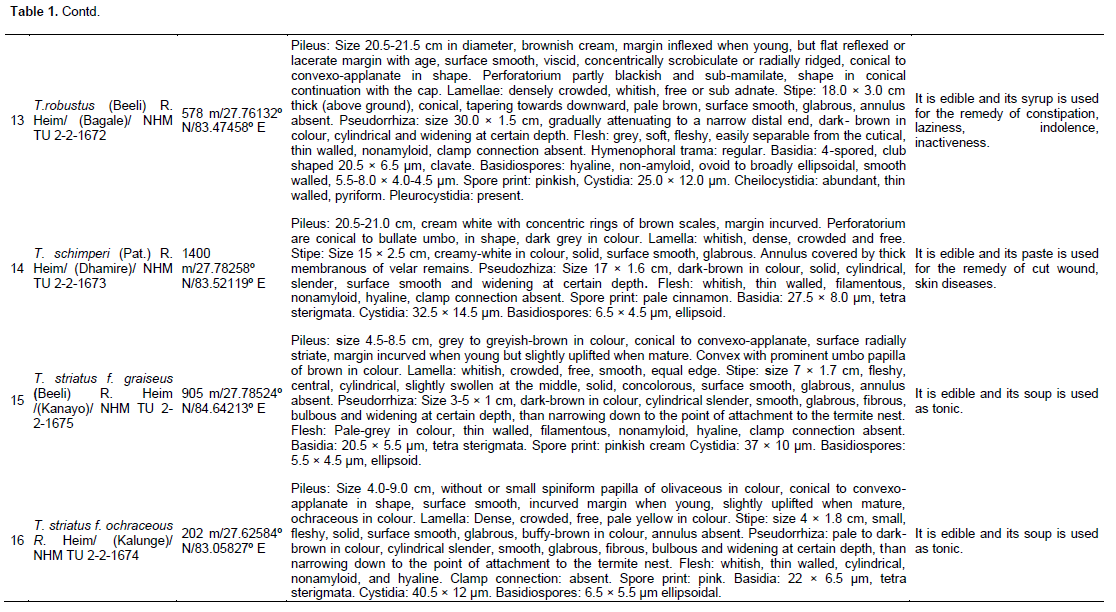
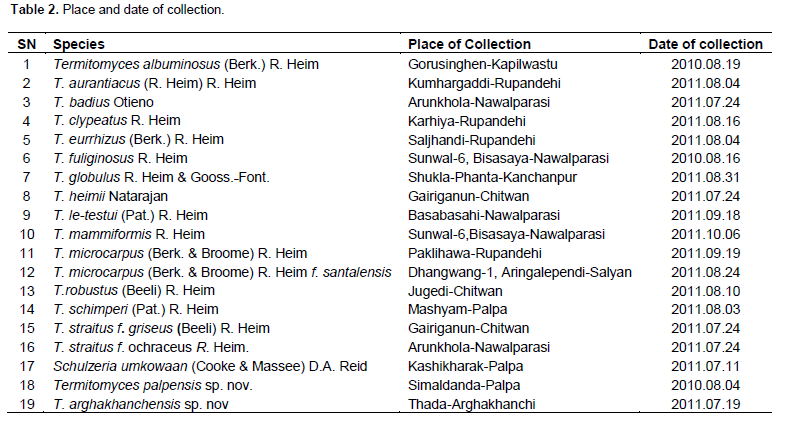
Twenty-seven sites (Table 3) were randomly chosen by Randomized Block Design method (RBD). The Participatory rural appraisal (PRA) technique (Freudenberg, 2011) was used for the local people to get information largely on nutritional as well as medicinal aspects. The utility of investigated taxa was explored to examine its nutritional and socio-biological aspect. The number of spots sampled represented 10 to 20% of the study sites (Elliott, 1971). The total of three spots sampled were taken from each topography, ranging east, center and west and Tarai, Siwalik and Midhill vegetational zone of Nepal. In each spot, 10 Quadrants of size 25 m × 25 m were located. The collection was entirely based on their sexual reproductive structures. The habit and habitat including ecological parameters were taken by the accessory equipment in appropriate places. This was calculated by the formula:

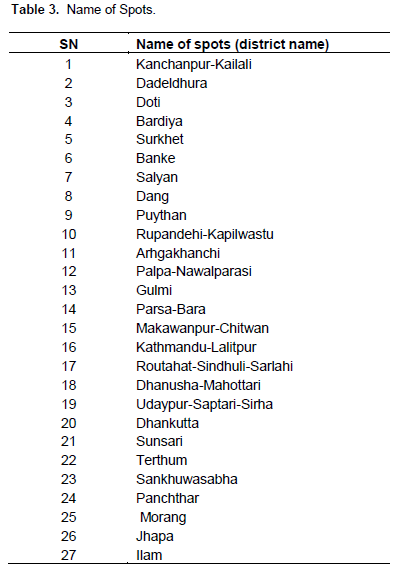
Macroscopic characters and microphotographs of the internal features of systematic importance, the local name along with their medicinal and traditional use by native people were also noted (Aryal and Budhathoki, 2015). All the primary data and samples were brought to the laboratory of Central Department of Botany, TribhuvanUniversity (TU), Nepal for microscopic studies, identification and experimental work (Aryal, 2015). Identification was done based on diagnostic morphological characteristics and microscopic examinations. The basidiospores (length and width) of each species were measured in the lab based on a range of 25 spores, and its mean values were provided, using a high-power microscope (Olympus CX22, magnification 100×). The literatures on the identification of the samples were given by: Heim (1977), Bels and Pateregetvit (1982), Singer (1986), and Harkonen and Mwassumbi (2003); and are on line data base such as: Biodiversity Library.org, Index fungorum, Jstor.org, Mycobank.org, tropicos.org). They were documented and prepared on their account with details, containing information on edibility, seasonal availability and nutraceutical relevance (Aryal and Budhathoki, 2014). The specimens are housed in Natural History Museum, Swyambhu, TU., Nepal.
In total, 241 species of Ascomycetes and Basidiomycetes belonging to 19 orders, 45 families and 95 genera were recorded (Table 4). A notable frequency of Agaricus augustus,Macrolepiota procera, M. rhacodes, Panaeolus sphinctrinus, Russula emetia, R. foetens, R. mairei, R. rosaceae, R. virescens, Cerrena unicolar, Daldinia concentric, Lentinus tigrinus, Peniophora quercina, Pycnoporus cinnabarinus, Trametes gibbosa, T. hirsute, T. versicolar and Tyromyces sambucens was observed. Out of the total collection, 48.13% macro fungi fall under Agaricales followed by Russulales, Polyporales, Boletales, Cantharellales, Cortinariales, Tricholomatales, Auriculariales, Helotiales, Hymenochaetales, Pezizales, Phallales, Tremellales Aphyllophorales, Leotiales, Lycoperdales, Pleurotales, Sarcomatales and Theleophorales (Figure 2), and it was found that respondents in the urbanized areas (near cities where the data were collected) hardly possessed any information about the edibility of these mushrooms. However, in the rural areas (Table 2), some respondents above 60 years of age possessed substantial knowhow about their edibility, recipes and medicinal utility, particularly their use as soup for persons suffering with indigestion, jaundice, diarrohoea, fever, physical weakness, muscular pain etc. (Table 1). Because of the importance attached
to these due to their culinary relevance, different species of this genus are popular by variety of their indigenous names in the areas of their occurrence. These are regularly collected during the monsoon season for personal consumption and some of them like T. albuminosus (Berk.) R. Heim, T. eurrhizus (Berk.) R. Heim , T. heimii Natarajan, T. mammiformis R. Heim, T. robustus (Beeli) R. Heim , T. schimperi (Pat.) R. Heim and T. straitus R. Heim for commercial sales to local vendors in different parts of the country.
The present study highlights the diversity of mushrooms and their uses in different part in Nepal.
The results of this study revealed that these mushrooms are nutritiously good for consumption. Documentation of food and medicinal use of Termitomyces in different social and cultural practices associated with their use in ethno medicinal practices in different parts of the nation is very important to sensitize the communities about the significance of these mushrooms. It plays a vital role in the enrichment of the socio-economic life of the rural as well as urban marginal people. Besides their consumption, the local or indigenous medicine also paves the way for the upbringing new industries. This knowledge provides enough background to appreciate the diversity and their relevance in ecosystem maintenance in general and human welfare in particular. Hence, there is urgent need to take steps to conserve and manage this minor forest product by checking over-exploitation through enforcement of regulations available under “Convention on International Trade in Endangered Species of Wild Flora and Fauna”.
The authors have not declared any conflict of interests.
The authors acknowledge the Nepal Academy of Science and Technology for providing the research grant. Thanks are due to Central Department of Botany, Tribhuvan University for providing the laboratory facilities and also to the Institute of Science and Technology for granting study leave. They are thankful to Dr. Maan B. Rokaya, Institute of Botany, Academy of Sciences of the Czech Republic, for valuable suggestions. Last but not least, sincere thanks are extended to the local people of the study area for providing information to the authors.